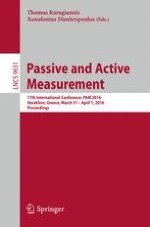2016 | Book
Passive and Active Measurement
17th International Conference, PAM 2016, Heraklion, Greece, March 31 - April 1, 2016. Proceedings
Editors: Thomas Karagiannis, Xenofontas Dimitropoulos
Publisher: Springer International Publishing
Book Series : Lecture Notes in Computer Science
